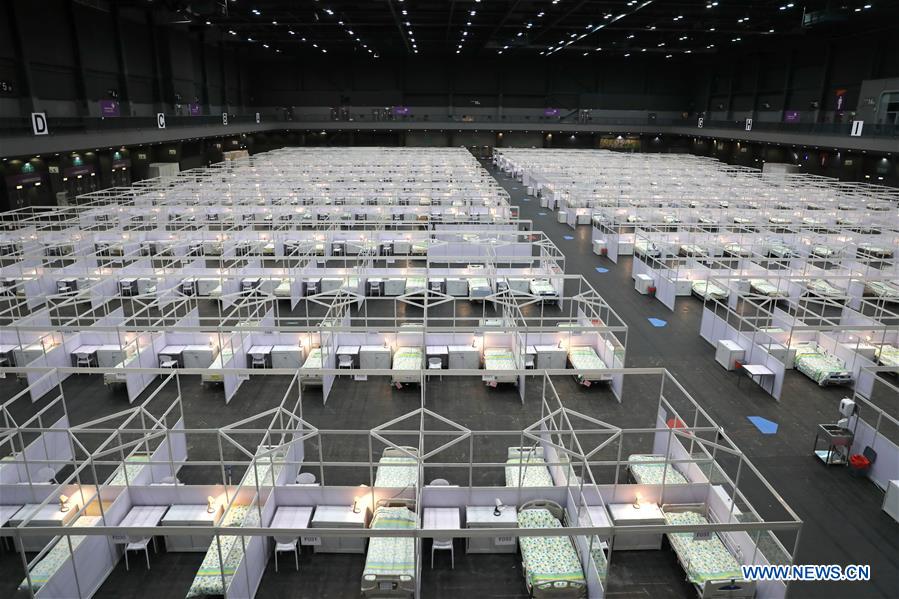With more measures taken, HKSAR gov't strives to contain COVID-19 resurgence
Amid a rampant resurgence of the novel coronavirus, the Hong Kong Special Administrative Region (HKSAR) government has intensified measures, expanded testing capacity, added quarantine facilities, and sought assistance from the central government to contain the epidemic as far as possible.
Amid a rampant resurgence of the novel coronavirus, the Hong Kong Special Administrative Region (HKSAR) government has intensified measures, expanded testing capacity, added quarantine facilities, and sought assistance from the central government to contain the epidemic as far as possible.
Photo taken on Aug. 1, 2020 shows the interior of a makeshift hospital for COVID-19 patients at the AsiaWorld-Expo in south China's Hong Kong. [Photo/Xinhua]
Hong Kong has seen a new round of COVID-19 infections in multiple communities since the beginning of July. New cases remained above 100 for 12 days in a row till Sunday. The rapid increase has put Hong Kong's hospital system under great strain.
Expanding virus testing has become a key.
The government introduced a wide-ranging testing scheme late July in virus-battered Tsz Wan Shan Community, offering free testing to residents in the area. At the same time, screening of market tenants, bus drivers and school staff has been stepped up. More than 500,000 people have been tested so far.
The first batch of seven virus testing professionals from the Chinese mainland, members of a 60-strong nucleic acid testing team established recently at the request of the HKSAR government, arrived in Hong Kong on Sunday afternoon.
HKSAR Chief Executive Carrie Lam has given clear instructions on how to carry out large-scale virus testing at a meeting previously.
The advance team has started working with relevant departments here and familiarizing themselves with testing facilities and procedures in preparation for the following large-scale nucleic acid testing.
Yu Dewen, the team leader, said Hong Kong's public institutions have a combined testing capacity of about 10,000 samples per day, which is far from enough to meet the needs of the current epidemic prevention. The support team will increase the daily tests to up to 200,000 or even more.
To alleviate the demand for isolation beds in public hospitals, the HKSAR government has opened a 500-bed makeshift hospital at the AsiaWorld-Expo near the Hong Kong International Airport and a community isolation facility at the Lei Yue Mun Park and Holiday Village.
The makeshift hospital has entered use since Saturday, and received 22 patients on the first day. A total of 14 doctors will take shift to care for the patients during the first week, and the number of on-site doctors will reach 28 by Aug. 8.
The second phase of the makeshift hospital at the venue is being prepared. About 120 to 140 COVID-19 patients will be admitted daily when completed.
A panel of six experts from Wuhan, also dispatched by the central government, has been set up to provide technical support in transforming more parts of the AsiaWorld-Expo into a makeshift hospital.
Meanwhile, the HKSAR government has introduced five rounds of increasingly stringent measures since July 9.
The so-far toughest measures include compulsory mask-wearing in all public places, both indoors and outdoors, and the group gathering limit of two people. Employers have also been encouraged to let employees work from home.
The HKSAR government also tightened the testing and quarantine arrangement for exempted persons such as sea and flight crews, in a bid to strengthen the prevention of imported cases.
To avoid gatherings and based on the experience of numerous countries and regions, the HKSAR government has postponed the 2020 Legislative Council election for one year, which has won the understanding and supports from various sectors of Hong Kong society.
"The SAR government will continue to devote all its efforts to fighting the epidemic. Only when the epidemic situation stabilizes can the health and safety of Hong Kong residents be guaranteed and the economy recover more quickly," said Chief Secretary for Administration of the HKSAR government Matthew Cheung Kin-chung.
The various measures taken by the HKSAR government are in the public interest and the central government is highly concerned about the health of people in Hong Kong, Cheung posted on his blog. "The HKSAR government expresses its heartfelt thanks."


